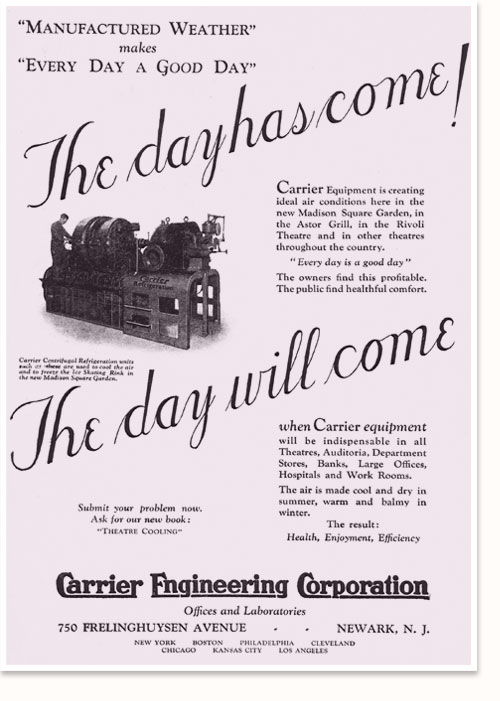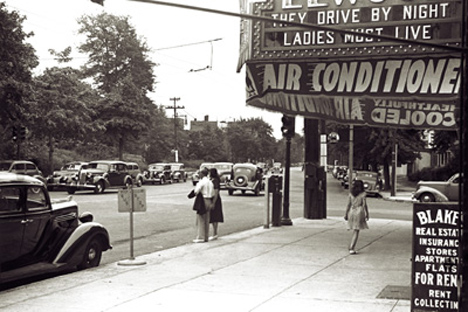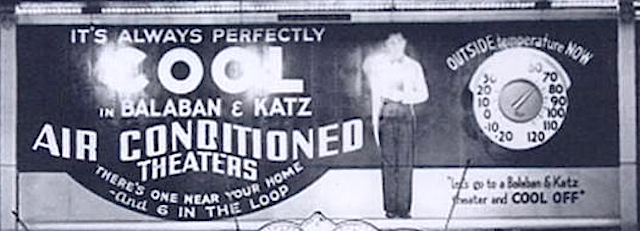Back to Part I: Some Like It Cool: The Rise of AC in the South
Air conditioning now dominates and our ability to cool our indoor climate may have radically changed Southern culture.

Aresnault argues that
Air conditioning has changed the southern way of life, influencing everything from architecture to sleeping habits. Most important, it has contributed to the erosion of several regional traditions: cultural isolation, agrarianism, poverty, romanticism, historical consciousness, an orientation towards non- technological folk culture, a preoccupation with kinship, neighborliness, a strong sense of place, and a relatively slow pace of life. The net result has been a dramatic decline in regional distinctiveness. In combination with other historical forces-such as the civil rights movement, advances in communication and transportation technology, and economic and political change-the air conditioner has greatly accelerated what John Egerton has called “the Americanization of Dixie.”
 Arsenault suggests that AC directly contributed to Southern population growth after the 1930’s by reducing heat related deaths and encouraging immigration from cooler Northern climates. In the 1950’s, when AC first started to appear in homes, migration out of the South was lower than it had been since the Civil War. By the 1960s there was more immigration into than emigration out of the South. This, combined with Northern tourists who could now tolerate Southern heat, a flux of Northern ideas and culture took hold in the South.
Arsenault suggests that AC directly contributed to Southern population growth after the 1930’s by reducing heat related deaths and encouraging immigration from cooler Northern climates. In the 1950’s, when AC first started to appear in homes, migration out of the South was lower than it had been since the Civil War. By the 1960s there was more immigration into than emigration out of the South. This, combined with Northern tourists who could now tolerate Southern heat, a flux of Northern ideas and culture took hold in the South.
As the son of a factory worker who has worked briefly in a factory as well, I can also attest to another important effect of AC. “Air conditioning also has played a key role in the industrialization of the modern South. After decades of false starts and inflated promises, industry came to the South in a rush after World War II.” With this brought stable jobs and economic growth, thereby raising the standard of living for many Southern families.
 Architecture also changed radically in the South because of air conditioning. Up to this point Southern architecture had largely reflected building techniques to allow for climate control such as the porch, high ceilings, and open floor plans (see my prior post about this). These architectural techniques, “developed to tame the hot, humid southern climate,” were all but discarded. Housing trended toward the styleless 3 bedroom ranch and track homes of the north. AC allowed for the construction of larger buildings like government buildings, skyscrapers, higher education buildings, libraries, and shopping complexes, also lacking in style. In many cases AC made a pit of Southern architecture. Think I’m being harsh? Aresenault is in agreement.
Architecture also changed radically in the South because of air conditioning. Up to this point Southern architecture had largely reflected building techniques to allow for climate control such as the porch, high ceilings, and open floor plans (see my prior post about this). These architectural techniques, “developed to tame the hot, humid southern climate,” were all but discarded. Housing trended toward the styleless 3 bedroom ranch and track homes of the north. AC allowed for the construction of larger buildings like government buildings, skyscrapers, higher education buildings, libraries, and shopping complexes, also lacking in style. In many cases AC made a pit of Southern architecture. Think I’m being harsh? Aresenault is in agreement.
Yet in recent years, thanks in part to air conditioning, southern particularism has been overwhelmed by an almost endless string of look-alike chain stores, tract houses, glassed-in high-rises, and, perhaps most important, enclosed shopping malls. The modern shopping mall is the cathedral of air-conditioned culture, and it symbolizes the placelessness of the New South.
In one final way, AC may have shaped Southern culture. The South has always been about a relationship with the land and climate. A direct and primal connection. In the old adage of blood, sweat, and tears…the South has concentrated on sweat. AC has removed many of us from our sweaty roots. Frank Tippett noted as well that AC has, “seduced families into retreating into houses with closed doors and shut windows, reducing the commonalty of neighborhood life and all but obsoleting the front-porch society whose open casual folkways were an appealing hallmark of a sweatier America.”
 Perhaps AC is not the angel of cool deliverance for the South but rather the icy devil in disguise. Or in the words of Arsenault, “General Electric has proved a more devastating invader than General Sherman.”
Perhaps AC is not the angel of cool deliverance for the South but rather the icy devil in disguise. Or in the words of Arsenault, “General Electric has proved a more devastating invader than General Sherman.”
Arsenault, R. 1984. “The End of the Long Hot Summer: the Air Conditioner and Southern Culture.” The Journal of Southern History. doi:10.2307/2208474.
`
